Applications Open: Graduate Student Policy Award

Future-proof Your Science Career
Three workshops in January to help you discover routes toward a fulfilling career in ecology. Join single events or register for the series and save!
Read more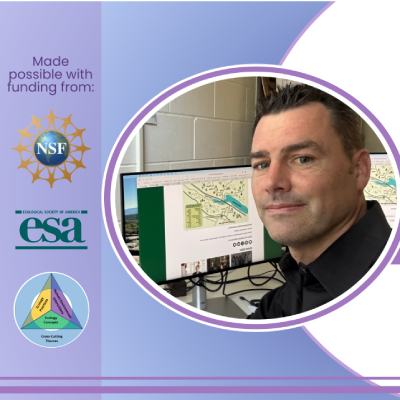
Taste Testing & Teaching
Everyone eats food, which makes it a great topic when applying the 4DEE Framework in the classroom! Babson College's David Blodgett joins the ESA Water Cooler 12/16 for a look at innovations in ecology education.
Read more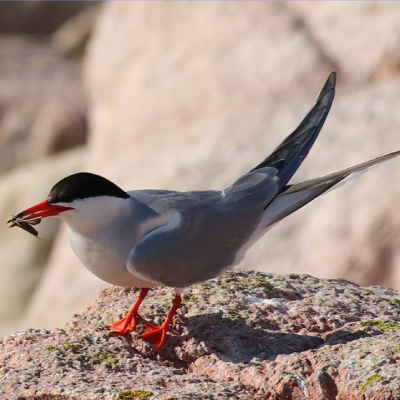
Journal Highlights
November's journal highlights include a long and winding road for urban pollinators; international treaties for the birds; mellow mycorrhizae; halos signaling ecosystem vulnerability; and prawns with giant appetites.
Read moreJournals & Publications
-
ESA's Journals & Publications
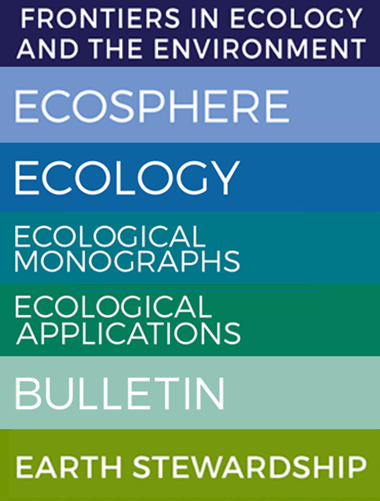
The Ecological Society of America has over 100 years of journal publishing history and offers some of the most widely read and cited journals in the field of ecology. The seven journals in our portfolio encompass a wide range of paper types to include an array of aims and scope of study, making them an important and accessible outlet for scientists, researchers, practitioners, professionals, citizen scientists, and others seeking to publish their work. ESA staff provide editorial support with our publishing partner, John Wiley & Sons, and several discounts towards publication in ESA journals are available from our publisher and from ESA. Publishing in ESA journals contributes to ESA programs for students, early career researchers, and underrepresented groups, and we thank our editors, reviewers, authors, and readers for their support.
-
Frontiers in Ecology and the Environment
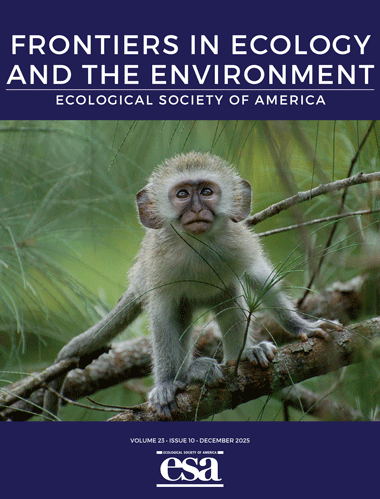
Protected areas are critical for the survival of species such as this juvenile vervet monkey (Chlorocebus pygerythrus), photographed here at Cape Vidal in South Africa. Although conservation efforts typically focus inside protected areas, many protected plants and animals move beyond their boundaries and into adjacent environments. In such surroundings, monkeys, for example, can provide ecosystem services (e.g., seed dispersal, aesthetic values) or disservices (e.g., spreading pathogens, stealing food). These “spillover effects” may have a strong influence on support for conservation, but they are poorly understood. Rigorous measurement of the kinds, frequencies, magnitudes, and spatial patterns of spillover effects will be central to improving management and policy responses to enhance or mitigate spillover benefits or costs, respectively, as discussed in a Concepts and Questions contribution from Cumming in the December issue of Frontiers,
-
Ecosphere
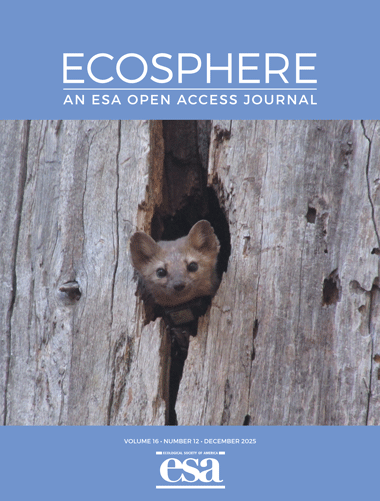
Martens (Martes spp.) are small-bodied, subordinate carnivores that are often described as habitat specialists, needing sufficient cover to escape larger predators and secure prey, but also as dietary generalists that can exploit a variety of vertebrate prey items depending on availability and abiotic and biotic conditions. Marten diet and foraging patterns were assessed at two spatial scales: (1) regionally, via new empirical data collected in the coastal and montane forests of western Oregon and northern California, USA, and (2) continentally, by reviewing and synthesizing previous studies of American (M. americana) and Pacific martens (M. caurina) across their North American distributions. In their contribution in the November issue of Ecosphere, Martin et al. show that forest cover and edge density have strong, contrasting effects on marten foraging patterns at regional scales and that focal prey species vary strongly among sampling sites. Continentally, they show marten diet differs among coastal and interior ecoregions and that martens exhibit high dietary plasticity and dietary diversity across North America. Marten foraging plasticity, exhibited through facultative variation among and within populations rather than obligate dependence on certain prey taxa, may be an important mechanism by which martens segregate niches with other carnivores and persist in increasingly dynamic and novel biotic and abiotic conditions.
-
Ecology
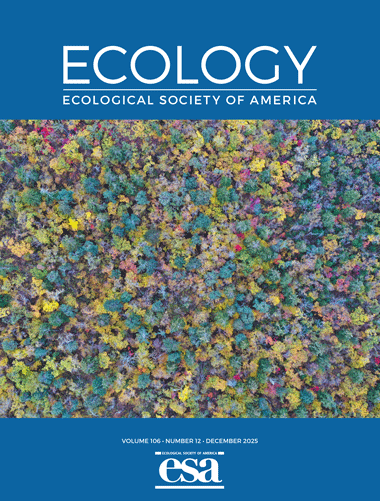
The photo on the December cover of Ecology features a drone view of the Manchurian mixed forests in fall. Evergreen conifers, Korean pine and Manchurian fir, tower above a broadleaf canopy dominated by Mongolian oak, temperate East Asian maples, and other regional endemics, including Amur cork tree, Amur linden, Castor aralia, Dahurian birch, and Manchurian walnut. This mosaic, characteristic of Northeast Asia's temperate–boreal ecotone, showcases the vertical structure and species richness of these forests. In their paper in the November issue of Ecology, Korznikov et al. use high-resolution drone imagery to analyze fallen tree dimensions across four sites near the Chinese–Russian border that were impacted by tropical storm Maysak in 2020, revealing that emergent conifers were disproportionately affected. With global climate change leading to weather extremes, tropical cyclones are emerging as a disturbance agent in Northeast Asia's temperate-boreal ecotone, transforming ecosystems by removing emergent conifers, simplifying canopy structure, and promoting broadleaf dominance.
-
Ecological Monographs
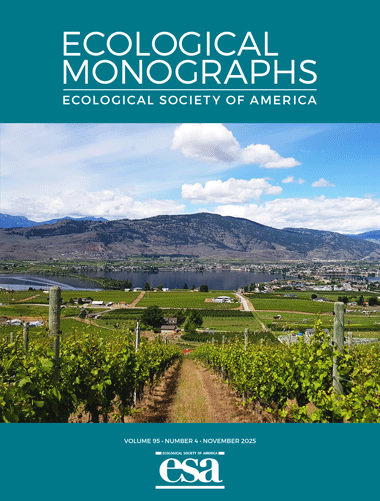
Fungal emerging infectious diseases pose a significant threat to global food production. The Botryosphaeriaceae fungal family comprises several pathogens of worldwide concern, causing severe diseases in a wide array of economically important crops, including grapevines. Research conducted by Silva-Valderrama et al. and published in the August issue of Ecological Monographs reveals an evolutionary trend towards increased host generalism within this family. The anthropogenic movement of plant species and agricultural practices, such as dense monoculture crop cultivation, may have enabled some pathogens to overcome geographical and phylogenetic constraints, thus creating new ecological opportunities for host shifts. The image on the cover of the November issue of Ecological Monographs shows multiple vineyards in Osoyoos, British Columbia, Canada.
-
Ecological Applications
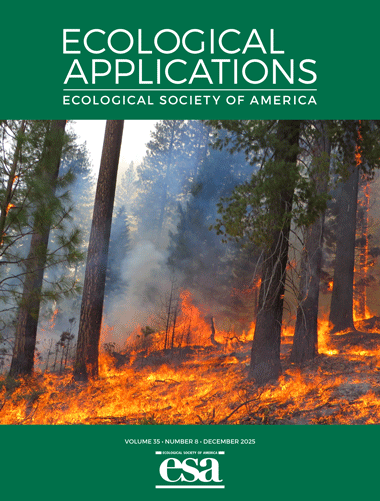
Using 20 years of data from the Fire and Fire Surrogate study, Zhu et al.'s article in the October issue of Ecological Applications quantified the carbon costs and synthesized the relative benefits and trade-offs of four wildfire mitigation scenarios: no treatment, prescribed fire only, mechanical treatment only, and mechanical thinning plus prescribed fire. The study shows that, despite the embedded carbon cost, treatments shifted carbon into more stable pools less vulnerable to wildfire and promoted rapid vegetation recovery with the managed forests remaining productive regarding carbon sequestration. The cover image, taken during the 2018 mechanical thinning plus prescribed fire treatment in a mixed-conifer stand in the Sierra Nevada, USA, illustrates smoke from combustion—an immediate carbon cost of wildfire mitigation.
-
The Bulletin
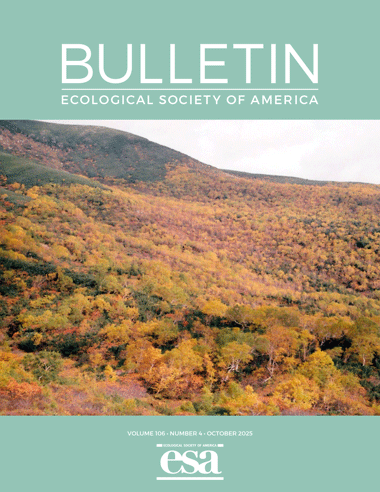
The October issue of the ESA Bulletin includes articles which report on education activities within the Ecological Society of America and a guide for effective group work for all students. The issue also includes a report from the transgender and gender nonconforming (TGnC)-focused session at ESA's 2024 Annual Meeting in Long Beach, California. A commentary explores terminology considerations for precision in scientific writing. This issue also include a book review and several photo gallery contributions related to articles published in the ESA journals.
-
Earth Stewardship
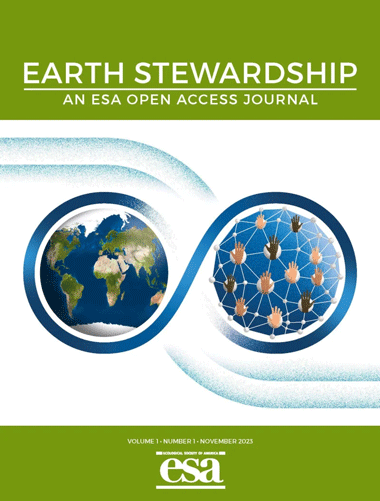
We are delighted to announce a call for submissions for Earth Stewardship. This exciting new Open Access journal, launched with our publishing partner, John Wiley & Sons, calls for a broad spectrum of scientifically and technologically innovative and groundbreaking contributions including cross-cultural perspectives from leading researchers, policymakers, traditional custodians of land and sea and indigenous communities. Earth Stewardship publishes applied and theoretical articles to promote a broad, intercultural, and participatory foundation for earth stewardship.

2026 Annual Meeting
Are you already thinking about our next meeting? Are you interested in submission types, deadlines, location, travel options and dates? Select the following link and to go to www.esa.org/saltlake2026/
Read more
ECOLOG-L
Access our long-standing email Listserv. Topics in the field of ecology include, research updates, news, job opportunities and more. A free subscription to the list serve allows you to choose what content you want delivered to you and how often.
Read more
Opportunity Fund Donations
Make a difference and fund programs which empower, educate and embolden both the current and next generation of scientists in the vast field of ecology.
Read more